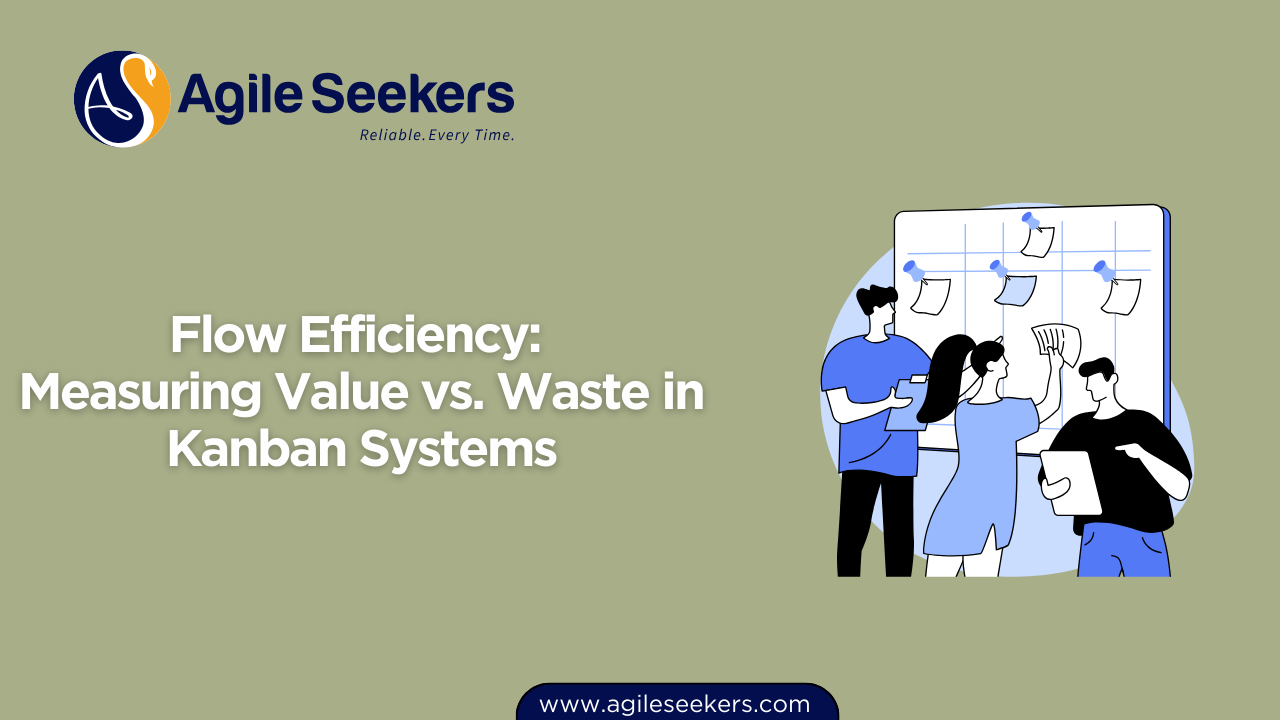Flow Efficiency: Measuring Value vs. Waste in Kanban Systems

Flow efficiency is a powerful indicator in Kanban that helps teams see how much of the total time work spends in the system is actual productive time. It highlights the difference between value-adding work and wasteful delays, giving teams insight into where to improve.
When teams focus only on lead time or throughput, they might overlook delays caused by bottlenecks, rework, or handoffs. Flow efficiency addresses that gap by showing how effectively a team transforms work items from start to finish.
This blog breaks down what flow efficiency means, how to measure it, and how it fits into improving delivery using Kanban practices—especially those covered in Kanban system design certification.
What Is Flow Efficiency?
Flow efficiency is the percentage of time a work item spends being actively worked on, compared to its total time in the system. It helps you differentiate between touch time (productive effort) and waiting time (non-value-adding delay).
Flow Efficiency Formula:
Flow Efficiency (%) = (Active Time / Total Lead Time) × 100
For example, if a user story spends 3 days being worked on and 9 days in queues or waiting, the flow efficiency would be:
(3 ÷ 12) × 100 = 25%
This means 75% of the time the work item was idle—waiting for someone to pick it up, approve it, or resolve a blocker.
Why Flow Efficiency Matters
Flow efficiency is especially useful in knowledge work, where waste is harder to see. You can’t see queues on whiteboards, but they exist in inboxes, backlog items, or task transitions.
A low flow efficiency isn’t necessarily bad, but it often reveals room for improvement. Reducing unnecessary waiting boosts predictability and throughput, even without adding people or tools.
In KMP 1 certification training, practitioners learn how to interpret this metric within a larger system, identifying opportunities for evolutionary improvement.
How to Measure It
You’ll need two data points:
-
Active Time: How long a team member actually worked on the item.
-
Lead Time: Time from commitment to delivery.
Many modern tools like Jira, Kanbanize, and SwiftKanban provide these metrics directly through built-in analytics dashboards. If your team is new to tracking this, start by manually recording timestamps as work enters and exits key stages.
Here’s a simple example to illustrate:
| Work Item | Active Time (days) | Total Lead Time (days) | Flow Efficiency (%) |
|---|---|---|---|
| Task A | 3 | 12 | 25% |
| Task B | 2 | 10 | 20% |
| Task C | 5 | 10 | 50% |
Ways to Improve Flow Efficiency
Flow efficiency doesn’t improve by rushing work. It improves by removing systemic blockers and redesigning how work flows.
1. Apply WIP Limits
Limiting work in progress reduces task switching and queues. Less clutter leads to better focus and faster handoffs.
2. Optimize Handovers
Many delays occur between stages—handoffs between QA, DevOps, or management. Minimize these delays by aligning schedules or reducing dependencies.
3. Redesign Work Policies
Use explicit policies to define when an item is truly ready to move forward. Clear criteria prevent partial work from clogging the system.
4. Visualize Waiting States
Add queue columns (e.g., "Ready for Testing") to your board. Making queues visible highlights idle time and creates conversation around improvement.
5. Address Root Causes of Delay
Use cumulative flow diagrams or scatter plots to identify common delay points. Fix root causes—don’t just push items faster.
These improvement techniques are core concepts in Kanban certification programs and help shift teams from reactive firefighting to continuous flow management.
Flow Efficiency Across Systems
At the team level, flow efficiency can guide tactical changes. But at scale, it becomes strategic. Leaders can use it to:
-
Identify value stream delays
-
Prioritize system-level investments
-
Improve cross-team coordination
-
Align delivery flow with business demand
In organizations using Portfolio Kanban or following the Kanban Maturity Model, flow efficiency supports data-driven change. It moves improvement efforts from intuition to evidence.
When Is Low Flow Efficiency Acceptable?
Sometimes work waits for valid reasons—customer feedback, compliance checks, or batch testing. The goal isn’t to reach 100% flow efficiency. The goal is to understand why time is lost and whether that loss is necessary.
Improving from 15% to 30% may offer significant business value, even if 70% of time remains idle. Focus on incremental gains rather than ideal targets.
Final Thoughts
Flow efficiency makes delays visible. It separates value from waste and offers clear evidence for what needs to change in your Kanban system.
It’s one of many tools that help you evolve from managing tasks to managing systems. If you're learning to build robust, data-driven workflows, exploring the Kanban system design certification path is a smart step forward.
It’s also a vital metric emphasized in KMP 1 certification, helping teams move from firefighting toward continuous, reliable delivery.
Also read - Dependency Management in Large-Scale Kanban Systems
Also see - Using Kanban with OKRs: Aligning Team Flow to Business Goals




















